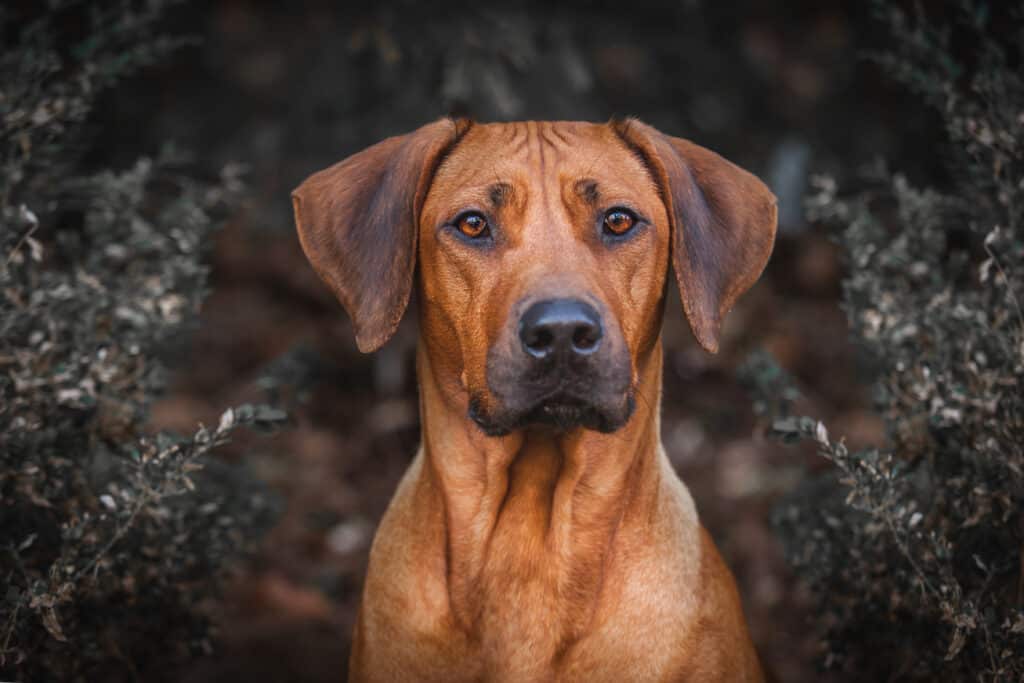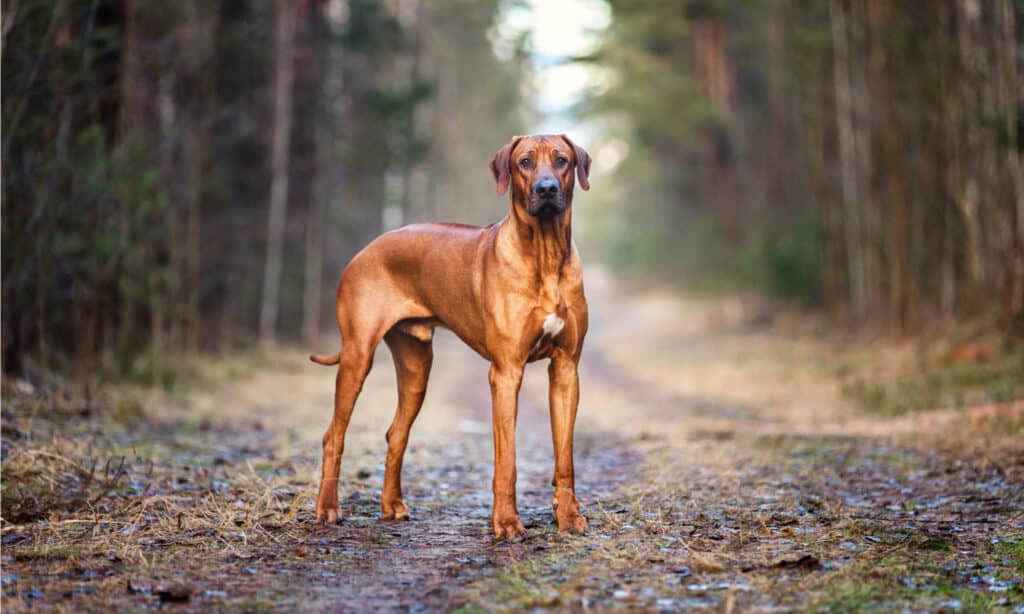It’s no secret that people have enjoyed the company and companionship of Rhodesian Ridgebacks for centuries. However, there are slight differences in the personalities of Rhodesian Ridgebacks based on their gender that may make one better suited for your family over the other. Today, we’ll discuss the history of this breed and explore four key differences between male and female Rhodesian Ridgebacks.
Rhodesian Ridgebacks: A Brief History

On average, Rhodesian Ridgebacks live to be between ten and twelve years old.
©Liudmila Bohush/Shutterstock.com
The Rhodesian Ridgeback is a strong and proud breed that has roots that date back to the 16th century. As you may have guessed from its name, this dog originates from Rhodesia, Africa which is located in current-day Zimbabwe. At this time, Dutch colonists had set up at the Cape of Good Hope and brought their native dogs along with them. The local Khoikhoi people had dogs as well, and eventually, these two dogs found themselves interbreeding. The Rhodesian Ridgeback resulted from a mix of these two breeds.
It wasn’t long before people saw the utility of keeping these dogs as protection animals and hunting companions. According to the American Kennel Club, “Lion-hunting required a specific set of both physical and mental skills: The dogs had to be strong enough to withstand the physical rigors of the hunt, but have ample agility to dart out of the way of slashing claws… The dogs had to be courageous enough to harry the king of beasts while the hunter positioned himself for the killing shot, but intelligent enough to know if their battle was a losing one, and so know when to retreat.” Rhodesian Ridgebacks embodied these qualities completely, and because of this, they found themselves growing more popular with each passing year.
Physical Characteristics

Rhodesian Ridgebacks grow an incredible amount during their first year of life.
©Eve Photography/Shutterstock.com
There’s no denying that the Rhodesian Ridgeback has all the features of a star athlete. This breed is physically strong and utterly loyal, which is why they make ideal guard dogs. However, male Rhodesian Ridgebacks are slightly bigger than their female counterparts. They typically weigh between 80 and 90 pounds whereas females will weigh between 60 and 75 pounds.
Female Rhodesian Ridgebacks have sleeker, smoother figures in contrast to the muscular build of the males. It may be difficult for someone with an untrained eye to discern the gender of a Rhodesian Ridgeback at first glance, so don’t beat yourself up if this doesn’t come easy to you. With time and practice, you’ll be able to see it from a mile away.
Behavioral Differences

Rhodesian Ridgebacks don’t bark much and make great house pets.
©olgagorovenko/Shutterstock.com
As with many breeds, the most noticeable difference between genders is in their personalities. For those of you who enjoy a needier, more attention-seeking dog, consider opting for a male Rhodesian Ridgeback. Although they might seem tough on the surface, these dogs are secretly mushballs who love to snuggle and bond with their owners.
Female Rhodesian Ridgebacks remain more independent overall than males. They are less interested in socializing, and may even be a bit aloof on occasion. Despite this, their loyalty remains the same. Although they may have a harder time making friends and bonding with people outside their immediate family, they are just as loving as male Rhodesian Ridgebacks. If you find yourself busy often and prefer a more self-sufficient dog, a female Rhodesian Ridgeback will be better suited for you.
Response to Training

This breed is utterly devoted to their owners which makes them excellent protection animals.
©nik174/Shutterstock.com
Male Rhodesian Ridgebacks actively seek validation from their owners, which may make them more open to training. Although they’re eager to please, they may be too excitable to remain focused on the lesson. In these cases, keep some treats on hand to give them positive reinforcement.
In contrast, female Rhodesian Ridgebacks mature quickly and may be more receptive to training. Because their energy isn’t as high, they’re able to stay focused on a task for a longer period of time and are overall less easily distracted. Both male and female Rhodesian Ridgebacks tend to get along better with dogs of the other gender. If you already have pets in the house, try to pick the opposite of what you have in order to avoid conflict or tension.
Health Considerations for Rhodesian Ridgebacks Depending on Their Gender

Although Rhodesian Ridgebacks do require a little more exercise than other breeds, two good walks a day should suffice.
©Osetrik/Shutterstock.com
As with any dog breed, Rhodesian Ridgebacks will have different health concerns based on their gender. Female Rhodesian Ridgebacks are at risk of developing ovarian cancer whereas male Rhodesian Ridgebacks will be susceptible to testicular cancer. However, these diseases are greatly mitigated by spaying or neutering early on in life. Unless your dogs are being used for breeding, keeping them intact leaves them vulnerable to these medical conditions. Speak to your vet to determine the best time to neuter your Rhodesian Ridgeback.
There are certain health conditions that both genders of Rhodesian Ridgeback may experience during their lifetime. Some of these are joint issues, thyroiditis, vision problems, skin conditions, and dermoid sinus. Buying your Rhodesian Ridgeback from a reputable breeder lowers the chance that they will develop these conditions, although there is always a chance
Final Thoughts
Personalities between male and female Rhodesian Ridgebacks will differ slightly, but generally speaking, these characteristics will be true of both genders. Because this dog has such a wide range of wonderful qualities, it gives them the ability to mesh well in a variety of households. Before making your final decision, it’s important to take some time to think about your personal family dynamics and determine which gender would be better suited for your home.
Thank you for reading! Have some feedback for us? Contact the AZ Animals editorial team.








